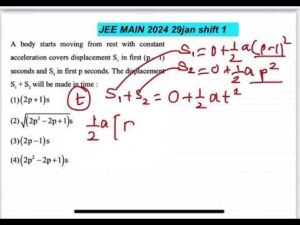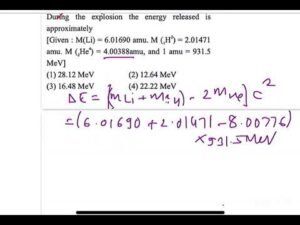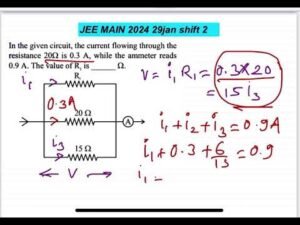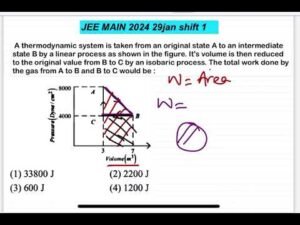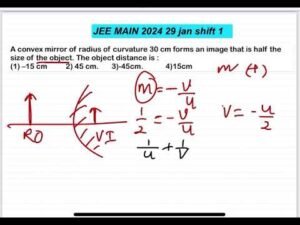Description
*2024(29th jan shift 2) solutions***😃
****2024 complete solution playlist**😃🤘🏻
*****2025 complete solution playsit*****
***All JEE Main/AIEEE questions playlist***😃🤘🏻
***All NEET PYQs playlist***😃🤘🏻
✅✅✅😃You can also find for chapterwise playlist of JEE MAIN and NEET on the channel👍🏻👍🏻✅✅✅
#jee,#jeemain,#iitjee,#neet,#pyq,#importantquestions,#jeemainpapersolution,#jeemain2025,#physicsmonk
In a single slit diffraction pattern, a light of wavelength 6000 Å is used. The distance between the first and third minima in the diffraction pattern is found to be 3 mm when the screen in placed 50 cm away from slits. The width of the slit is ______x10^-4 m
Welcome to Allen.AskDoubtnut.com – India’s Largest Platform for Instant Doubt Solutions
Allen.AskDoubtnut.com is the ultimate destination for instant video solutions to your doubts in Physics—from Class 11th to JEE Advanced and NEET level. With a growing library of over 15 lakh+ expert-created video solutions, we make learning fast, easy, and effective.
Just click a photo of your doubt using the AskDoubtnut in the end and submit in google, and get an instant, step-by-step video explanation. It’s the simplest way to solve doubts in seconds—whether you’re studying for CBSE board exams, IIT-JEE, NEET, or any other competitive exam.
Why AskDoubtnut.com?
• 10,00,000+ Free Video Solutions
• Covers NCERT, JEE Main, JEE Advanced, NEET, and State Boards
• Unlimited Doubt Solving with Just One Click
• Instant, Concept-Based Answers by Experts
• 24×7 Learning Support via the AskDoubtnut App
Trusted by millions of students across India, Allen.AskDoubtnut.com helps you turn doubts into confidence. No more waiting—ask, learn, and grow with Allen.AskDoubtnut.com!
- NEET 2025:To an ac power supply of 220 V at 50 Hz, a resistor of 20 Ω, a capacitor of reactance 25
- NEET 2025: (By 2 methods)In some appropriate units, time (t) and position (x) relation of a moving p
- NEET 2025: AB is a part of an electrical circuit (see figure). The potential difference “VA – VB”, a
- NEET 2025:A ball of mass 0.5 kg is dropped from a height of 40 m. The ball hits the ground and rises
- NEET 2025:The current passing through the battery in the given circuit, is:
Frequently Asked Questions
How to prepare for IIT-JEE Physics?
To prepare for IIT-JEE Physics, focus on understanding concepts rather than memorizing formulas. Practice solving a variety of problems, especially previous years’ questions. Create a study schedule that covers all topics, with extra time for challenging areas like Mechanics and Electromagnetism. Regular revision and mock tests are essential for success.
What is the difference between elastic and inelastic collisions?
In elastic collisions, both momentum and kinetic energy are conserved. Examples include collisions between hard billiard balls. In inelastic collisions, only momentum is conserved while some kinetic energy is converted to other forms like heat or sound. Most real-world collisions are inelastic to some degree.
How does electromagnetic induction work?
Electromagnetic induction is the process of generating an electromotive force (EMF) in a conductor by changing the magnetic field through it. According to Faradays Law, the induced EMF is proportional to the rate of change of magnetic flux. This principle is the basis for generators, transformers, and inductors, which are essential components in electrical power systems.




